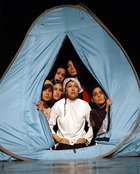"Occupied Territories" Straddling a Minefield


The organizers of the 23rd Fajr Theater Festival in Teheran were glad that the performance of "Occupied Territories" that opened this year’s festival failed to spark the expected storm of outrage.
The actresses who performed in the piece do not have to worry that they have jeopardized their future careers, and Berlin-based director Helena Waldmann breathed a deep sigh of relief in the knowledge that her production had finally made it onto the Iranian stage.
The German-Iranian project all began when Waldmann was invited to participate in a 14-day workshop in Teheran. Her experiences with the actresses there were so positive that she decided to collaborate with a group of six Iranian women on a joint production.
The Center for Dramatic Arts in Teheran and the Goethe Institute joined in as co-production partners. Additional support came from the Berlin cultural fund.
Tents as ploy
The idea of working with tents originally came from the workshop. This approach was in part a ploy to allow the dancers to undermine the restrictions currently in force in Iran.
Although the general proscription against women dancing in front of a mixed public has softened somewhat by now, it is still forbidden to display the female body in a way that could be construed as erotic or provocative, and the criteria applied here are just as arbitrary as they are rigorous.
In addition, "chador" in Farsi doesn't only mean "tent," but also the all-enveloping garment that many Iranian women traditionally wear. This naturally provided the opportunity for a double entendre playing with the ideas of coercion and protection, inner and outer worlds, restriction and inner freedom.
Turning away outsiders
Last summer, the four professional actresses and two dancers worked together with Helena Waldmann to conceive a series of images in which the tents proved to be surprisingly expressive elements.
The six actresses stay in their tents for the entire course of the performance, but after many rehearsals and strenuous training, this outer skin becomes a singularly expressive medium. The tents turn away an outsider, perform a wild dance full of vital energy and touchingly take another tent into their inner circle.
"Outsiders" at two dance festivals in Hanover and Munich got a first taste of the piece. The sequence of scenes was still somewhat unpolished, and important elements such as light, slide projections and music were missing, but viewers were nonetheless quite taken with the performance.
Fear of performance ban
However, the reactions made it apparent that both the German audience and the critics expect a production from Iran to be about Iran, and that they understood the work as dealing with the repression of women in that country.
A candid interrogation of the role of women at the opening of the most renowned Iranian theater festival, which was once founded to celebrate the revolution, seemed unthinkable. As the group went through final rehearsals in Teheran in early January, the question of what aspects might be construed as a criticism of the situation in Iran and thus provoke a scandal, became increasingly acute.
Waldmann feared that the censors would destroy her work. The actresses and the dancers worried that their participation could lead to them being banned from future performances.
The festival management became nervous when at the Iran Zamin Theater Festival in the provincial town of Ahwaz the artistic director was thrown into prison because the performance by an Armenian theater troupe did not comply with the country’s moral strictures.
The Iranian parliament, which since February is once again in the hands of a conservative majority, and which sees itself as the guardian of an Islamic code of behavior, could be sensed lurking menacingly in the background.
The original working title "Letters from Teheran" had already been changed to "Letters from Tentland" in order to keep the perspective from focusing too narrowly on Iran. Waldmann emphasized that her piece has to do with general human states such as homelessness, isolation, strangeness and awakenings, which do exist in Iran, but not only there. "Letters from Tentland" then became "Occupied Territories."
Concessions to the censors
The censors, who appeared two hours before the premiere to grant their final approval, demanded even more: the projection of a female dancing figure onto the tent walls had to be omitted, as well as a scene in which one of the tents tumbles wildly over the stage.
The singing had to be quieter, and only the determined protests of the Iranian assistant rescued the invitation for female audience members to come backstage at the end of the performance to talk with the actresses.
What the premiere audience ended up seeing is a piece that is open for all kinds of interpretations. "Occupied Territories" can be seen as a work about Iran, or as a piece about refugee camps, or perhaps as an exploration of the basic human condition.
Conservatives reserve judgment
The reactions were varied. While some audience members found this unusual form of theater somehow irritating, or complained about the lack of a recognizable story, women were especially enthusiastic, identifying with many of the images. The anticipated storm of indignation on the part of the conservatives never came.
"Occupied Territories" is slated for 20 more performances in Teheran this April and has already received invitations from German theaters and various international festivals.
In Teheran, nothing more will be changed in the authorized version, but the director has yet to decide whether outside of Iran parts will be shown that fell victim to censorship.
Martin Ebbing
© Qantara.de 2005
Translation from German: Jennifer Taylor-Gaida
To read another article on Qantara.de about Teheran's Fajr Theater Festival, click here.